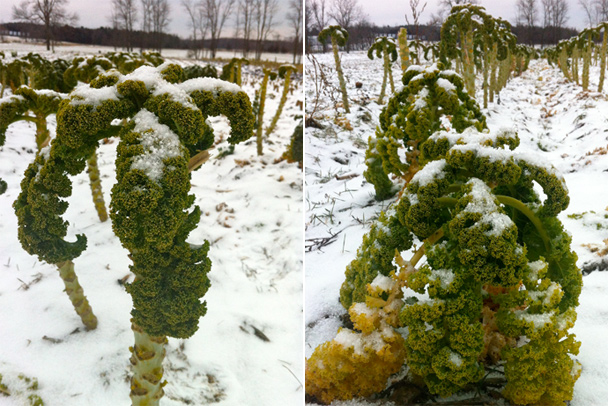We have passed the solstice, and the farm is glazed in its hollows with scant dry snow. The afternoon light is slanted and weak, filtered through low clouds. The winter has been exceptionally mild so far, but the wind today is brisk, blowing in some new weather. The forecast calls for a stretch of deeply frozen nights. Jane and I are making the rounds, checking water tanks and hydrants, the door to the root cellar, the quality of the ice at the edge of the skating pond. Jane is bareback on her fat white pony. She is a dreamy four-year-old, and on her own two feet, she’s liable to meander. If we want to be back home before the baby wakes up from her nap, the pony is the only way to go. Down the driveway, past the mailbox, along the path to Monument Field, the pony picking her way carefully around frozen puddles, Jane holding tight to her thick mane.
Monument Field is full of trash from last summer’s vegetables: beheaded stalks of broccoli, matted tops of leeks, and the dry brown vines from 1,500 tomato plants. Five months ago, they were all so vigorous and the sun so strong that it was hard to imagine winter and death would overtake them. Then the field was full of the noise of work every day. Now it is so quiet that even Jane and the pony feel it and hush. The only movement is a snow devil scuttling over the parsnips, and the faint rattle of the nude, spent stalks of corn.
We reach the rows of kale, green in a world of white and muted browns. The leaves come off the stalks frozen and stiff but become pliant in our bare hands. When I first started farming, eight years ago, I didn’t know there were plants like this that not only can stand frozen temperatures but become sweeter for it. My husband, Mark, refuses to consider kale food until it has been through at least one good frost. Parsnips aren’t worth eating, he says, until they’ve weathered a whole winter underground.
The farm we run in Essex, New York, produces a full diet, year-round, for 200 people via our CSA. We ourselves buy a few things from the store, but most of our food comes from what we grow and raise. Sometimes, when I describe what we do here to prospective members, their brows wrinkle, and I know what’s coming next. “What do you eat in the winter?” they ask. They are surreptitiously checking my gums for scurvy, my legs for rickets. Oh, ye of the wheeled and squeaky cart, you are in for a pleasant surprise. Winter food is not something you have to grimly bear. If your farmers have done their work and had a bit of luck, winter is a time of great abundance. To me, it’s the very best time to eat locally, even way up here in the north country. Right now, thanks to our root cellars, we are showcasing carrots, cabbage, Brussels sprouts, beets, potatoes, celeriac, onions, shallots, leeks, and two kinds of winter squash, plus that kale we’ve come for. We have sweet corn and broccoli in our freezer, sauerkraut in crocks, and tomatoes in jars on the shelf.
Jane and I tuck the rigid kale into our bag, let the pony loose in the pasture, and head back to the house. I’ve contributed a bottle of Pinot Noir to the righteous cause of beef bourguignon, and it’s been cooking all afternoon, filling the kitchen with fragrant steam. This is what I’ll never get about sous-vide. To me, cooking something vacuum-sealed in plastic, stuck in a machine, sounds about as much fun as doing the tango in a wet suit. Half the pleasure of winter food is the way it asks to be cooked long and low, so that it suffuses the air with moist heat, and satisfies the skin and the nose before you even think about sitting down for dinner.
The bread is baked and the potatoes are boiled and the beef is meltingly tender. All that’s left to do is finish the sauce and cook the kale. Jane’s little sister, Miranda, wakes up and toddles around the kitchen, competing with the dog for dropped scraps. I strip the kale leaves from stems and chop, steam it until it is soft, and dress it with salt, olive oil, and a squeeze of fresh lemon. If it hadn’t been kale, our salad course might have been shredded carrots with vinaigrette, or beets tossed with orange juice, walnuts, and toasted cumin, or celeriac with apple and homemade mayonnaise. I think I might be happiest at times like this, in a steamy kitchen, working at the chopping block, with two children underfoot and the cold, early dark pressing at the windows. Mark comes in from his evening rounds, and I almost tell him so—but he’d laugh at me, because I make declarations like that all the time.



 Pinterest
Pinterest


